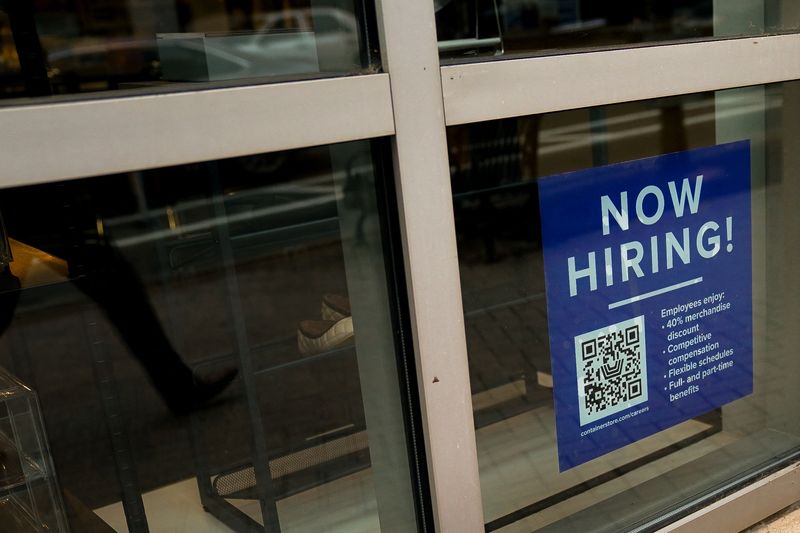By Lucia Mutikani
WASHINGTON (Reuters) - U.S. job openings edged up in February, though labor market conditions are gradually easing in support of expectations that the Federal Reserve will start cutting interest rates by June.
The Job Openings and Labor Turnover Survey, or JOLTS report, from the Labor Department on Tuesday showed there were 1.36 vacancies for every unemployed person in February, down from 1.43 in January. The decline in the vacancy-to-unemployment ratio reflected a spike in unemployment at the start of the year. Economists, however, argued that the drop in the ratio in February did not mark a material shift in the labor market.
"There is nothing here to worry Fed policymakers, who want a strong labor market, but the very slow progress in reducing the apparent excess demand for labor is not likely to encourage the Fed to cut interest rates in the immediate future," said Conrad DeQuadros, senior economic advisor at Brean Capital in New York.
Job openings, a measure of labor demand, edged up 8,000 to 8.756 million on the last day of February, the Labor Department's Bureau of Labor Statistics said. Data for January was revised lower to show 8.748 million unfilled positions instead of the previously reported 8.863 million.
Economists polled by Reuters had forecast 8.750 million job openings in February. Vacancies peaked at a record 12.0 million in March 2022.
Cleveland Fed President Loretta Mester, currently a voting member of the Fed policy-setting committee, said on Tuesday she anticipated that the U.S. central bank "will be able to move rates down gradually." The timing remains unclear.
Fed officials last month left the central bank's policy rate unchanged in the current 5.25%-5.50% range, having raised it by 525 basis points since March 2022.
Policymakers anticipate three rate cuts this year. Financial markets expect the first rate reduction in June.
There were an additional 126,000 open positions in finance and insurance in February. Unfilled positions in state and local government, excluding education increased by 91,000, while arts, entertainment and recreation had 51,000 more job openings.
But vacancies in the information industry declined 85,000, while the federal government had 21,000 fewer open positions.
The job openings rate was unchanged at 5.3% for the third straight month. Medium-sized businesses accounted for the increase in overall job openings. Small businesses with 10 to 49 employees saw unfilled jobs declining 152,000. Job openings were higher in the West, while the South reported a large decline.
Stocks on Wall Street were trading lower. The dollar slipped against a basket of currencies. U.S. Treasury prices fell.
QUITS CLIMB
Hiring increased 120,000 to 5.818 million. It was driven by retail trade, with 78,000 hires. There were also notable gains in transportation, warehousing and utilities. Much of the hiring came from small businesses with 10 to 49 employees, and was in the South. The hires rate rose to 3.7% from 3.6% in January.
"We view the openings data as indicative of demand for labor still being strong relative to supply but with there being less imbalance recently than there was a couple of years ago," said Daniel Silver, an economist at JPMorgan in New York.
The number of workers resigning from their jobs, likely for greener pastures, increased 38,000 to 3.484 million in February.
About 77,000 retail workers quit their jobs, while resignations increased 42,000 in the professional and business services sector. Most of the quits were in medium-sized firms. But quits decreased 53,000 in accommodation and food services.
The quits rate, viewed as a measure of labor market confidence, was unchanged at 2.2% for the fourth consecutive month. A steady quits rate suggests wage increases will likely continue to moderate, which bodes well for overall inflation.
Layoffs increased 128,000 to 1.724 million, the highest level in 11 months, driven by the arts, entertainment and recreation industry as well as accommodation and food services. They were mostly among small and medium-sized businesses and were concentrated in the South and Midwest. But job cuts decreased in professional and business services.
The layoffs rate climbed to a still low 1.1% from 1.0% in January. Low layoffs have accounted for most of the employment gains in recent months.
The Labor Department is expected to report on Friday that nonfarm payrolls increased by 200,000 jobs in March, according to a Reuters survey of economists.

The economy added 275,000 jobs in February. The unemployment rate is forecast unchanged at 3.9%.
"We expect job growth to moderate over the course of this year as demand for labor softens but remain positive," said Nancy Vanden Houten, U.S. lead economist at Oxford Economics in New York.